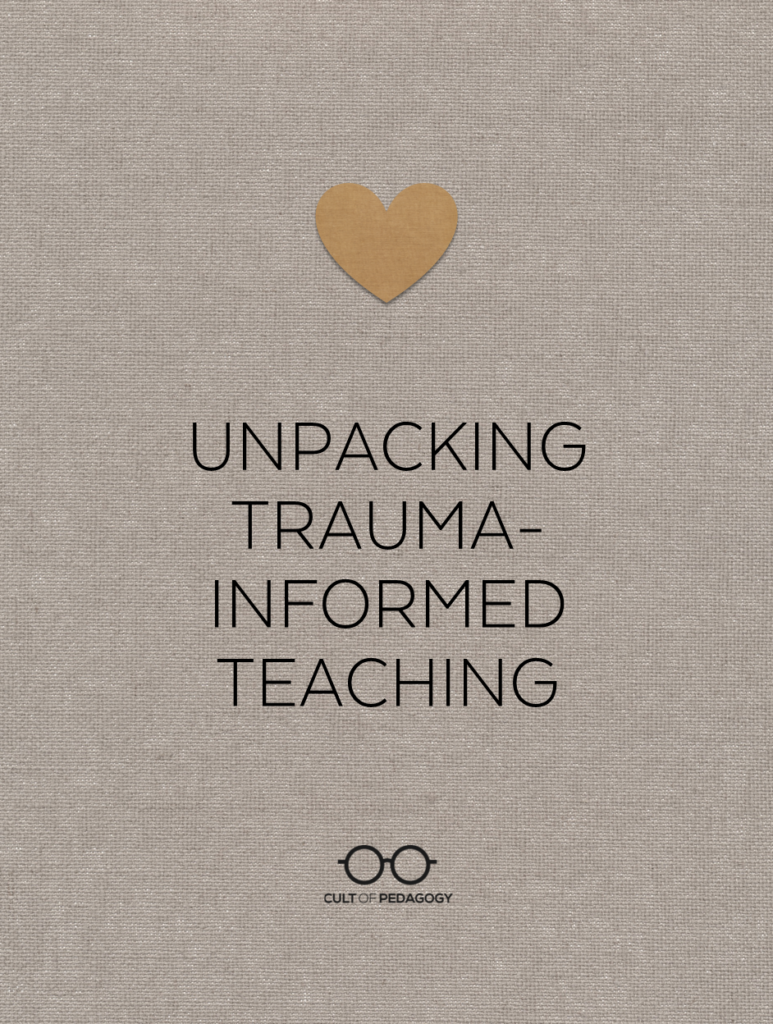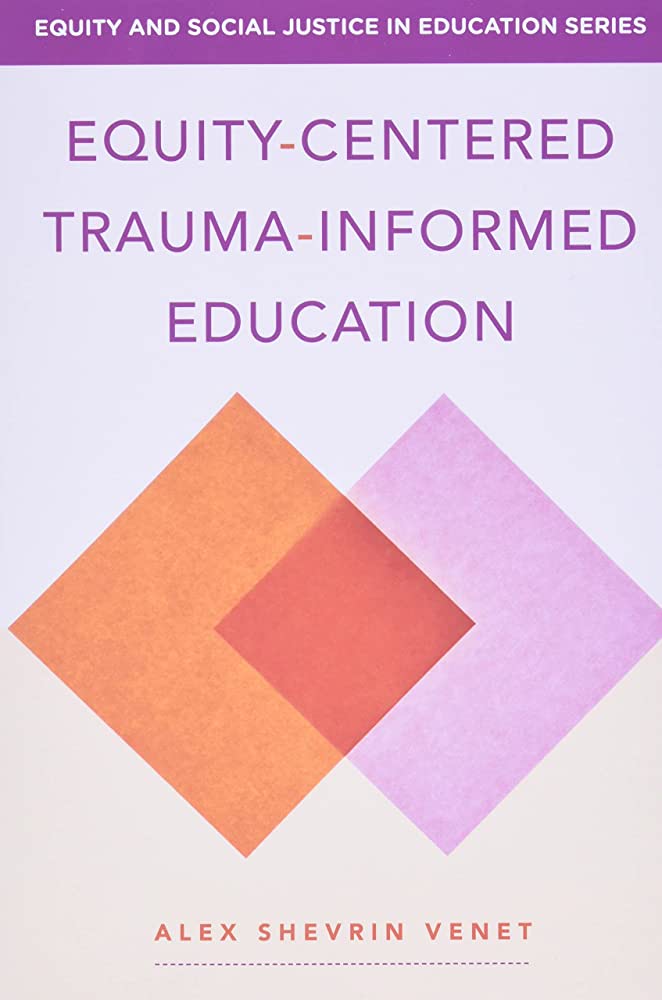
Listen to the interview with Alex Shevrin Venet (transcript):
Sponsored by EVERFI and Giant Steps
This page contains Amazon Affiliate and Bookshop.org links. When you make a purchase through these links, Cult of Pedagogy gets a small percentage of the sale at no extra cost to you. What’s the difference between Amazon and Bookshop.org?
My understanding of the word “trauma” has evolved over the last few years. It used to be limited to incidents that were objectively harmful and almost always severe, events that involved some kind of violence, like experiencing or directly witnessing a physical assault, or a tragedy of some sort — a natural disaster, vehicle collision, something that caused destruction or bodily harm.
While these things still sit squarely under the trauma umbrella, that umbrella has expanded to include lots of other experiences that can have negative and long-lasting impact, things like neglect, emotional abuse, and harassment. While some lives are much more trauma-heavy than others, every life contains some degree of trauma, and it affects each of us differently. In fact, it is the way we process and experience certain events that defines how traumatic they are; two people may process the same episode quite differently, making it a traumatic event for one but a minor blip on the radar for the other. This broader definition does not water down the concept of trauma; it makes it universal. And this means it will show up for many, if not all, of our students, and for ourselves.
Making educational decisions with a sensitivity toward trauma — commonly referred to as trauma-informed education — has gotten more attention in recent years, and there’s a long list of reasons why, including the rise of childhood depression and anxiety, pandemic-related stressors, economic struggles, and a constant threat of gun violence, to name just a few. I’ve wanted to do an episode on this topic for a while, and I’ve found someone pretty incredible to help me do that.

Alex Shevrin Venet is someone whose work has dramatically expanded my own understanding of trauma-informed education, and my hope is that in sharing her approach with you, it will expand yours as well. Her 2021 book, Equity-Centered Trauma-Informed Education, is one I wish I’d had available to me before I started teaching; it would have made a world of difference in how I saw my students and designed my classroom practices.
The book offers a holistic and nuanced exploration of what this work looks like in practice, and it does so with equity at the center: Students at the margins are often subjected to additional harm from systems of oppression built into all facets of our society, but these harms are not always considered in conversations about trauma-informed teaching. Venet ensures that while we are making schools safe, welcoming, and accessible for all students, we are doing so through the lens of equity, then taking that work further to make the systemic changes that will reduce harm for all students.
On the podcast, Venet and I talked about what trauma-informed teaching looks like in practice, how some approaches to this work miss the mark, and how teachers can start applying the principles of good trauma-informed teaching right away. You can listen to the episode above or read the transcript. Here’s a summary of our conversation.
Defining Trauma and Trauma-Informed Education
“One of the really hard things in trauma-informed education and trauma in general is that there’s no agreed-upon definition for either of those things,” Venet explains. “So many different fields of study contribute to it and there’s a lot of different models.”
The simple definition for trauma that she starts with is “a response to life-threatening events, dangerous or harmful conditions, or a prolonged stressful environment.” While this includes acts of violence or natural disasters, it can also be experiences like “living in a community where you’re constantly not accepted and experiencing microaggressions…that low-level stress over time has that same impact as maybe a one-time event, or a similar impact.”
Venet adds that “Trauma is also a response to something; it’s not the thing itself. And so every person might experience trauma differently or in different circumstances. The impact of trauma can be really broad-ranging. It can be physical, emotional, social. Really, it’s about disrupting our core sense of safety, which then has all kinds of ripple effects.”
She sees the most powerful trauma-informed education as working on three different levels:
- It RESPONDS to trauma. “Students and educators have experienced trauma, and so we want to make sure that the environment is sensitive to that, is responsive, they’re getting support, they are equitably accessing the school environment.”
- It DISRUPTS existing trauma. “School does not have a magical bubble around it where trauma only happens outside the bubble but then inside the bubble, everything’s perfect. Schools are full of people, and people can harm each other. And so schools need to look carefully at how someone might experience trauma here, and then how do we disrupt that from happening?”
- It PREVENTS future trauma. “Trauma-informed education looks at school as a potential place of change in society for preventing trauma from occurring in the future, as places where students can learn, how can I disagree with people without harming them? How do I manage my emotions so that I’m not being cruel to others? How can I help to disrupt systems that are harming myself, my community, or others that I care about?”
An Equity-Centered Lens
Venet’s approach to trauma-informed teaching puts equity at the center. Throughout her career, she had always been troubled by the fact that so many schools — and so many experts, for that matter — seemed to put equity and trauma work in two separate buckets.
“Trauma is not equally distributed necessarily,” she explains. “Some people are put in harm’s way by our society because of systems of oppression. If you are a transgender teen, our society is putting you in harm’s way through all of these decisions that are being made right now around removing your access to healthcare, and banning you from being able to talk about your identity, or learn things in school about people in your community. Even though anyone can experience trauma, society makes it so that some people are more likely to experience trauma because of these harms.”
And once a person from a marginalized group experiences trauma, their access to resources may be limited by those same systems, students who “needed particular therapy or counseling, but their health insurance didn’t cover it, or they didn’t have the transportation to get there, or the only available therapist didn’t understand some of their identity or their background. And so equity issues are really woven into the experience of trauma.”
She also found that much of the equity work being done in schools looked very similar to trauma-informed approaches, “being caring, paying more attention to the humans that we all are, looking at our strengths. All of those things feel really similar. And so when I was formulating this model, it was really about how can we tie all this together and really see this work as intertwined, as opposed to We have an equity committee over here, and a trauma committee over here, and they’re not really talking to each other. We can do so much better work if we’re doing it collectively.”
Clearing up Misconceptions
In the same way that trauma-informed teaching doesn’t have a single agreed-upon definition, it may also look different in practice, depending on where you look. This can leave room for misconceptions or practices that keep some students from getting the support they need. Venet clears up some of the biggest misunderstandings she’s seen.
Effective trauma-informed education is universal, not based on a label or a score.
A common practice in trauma-related work is determining a person’s ACE score, a metric that measures the number of adverse childhood experiences. While Venet recognizes the value in recognizing the degrees of impact early childhood adversity can have on a person, she’s concerned about the limitations of this approach.
“If we only base our trauma-informed practices on a narrow label like that, then we’re going to miss students who maybe the eight items on that checklist don’t represent,” she says. “For example, experiencing racism is not one of the ACEs on that checklist, and so that certainly causes trauma to a lot of people but it might not show up in a score.”
In the book, Venet also expresses concerns about the use of the Multi-Tiered System of Supports (MTSS) as a framework for offering support at increasing tiers, because they can limit who receives support and place deficit-focused labels on students. “Whether a child ‘needs’ a higher-tier intervention is typically based on the child’s adherence to school-created norms that place high value on order and compliance…(these) tiers often become euphemisms, with teachers using the tiers as coded language for children who do not fit into narrow definitions of ‘appropriate behavior.’ ‘Tier 3 student’ isn’t a label we should apply to any child, just as we shouldn’t apply the label ‘trauma kid'” (64).
Venet advocates for a more universal approach, where supports are offered to all students whenever they need them. “They don’t need to have somebody evaluate them or assess them or determine that they need it. The student themselves can say hey, I think I need some extra help and I know how to get it because my school makes a point of telling me who all the people are that I can turn to. When we create the opportunity for people to get support for themselves, it’s very empowering.”
Effective trauma-informed education is proactive, not reactive.
“We don’t want to wait until after a crisis to start implementing trauma-informed education,” Venet explains, “in part because all of us have already been through a variety of crises, right? COVID was a crisis, so there is no such thing as ‘before trauma impacts your school,’ because it already has, so we want to get started now. And with individual students, even if you feel with some degree of certainty that a particular kid has not yet experienced trauma — although often we’re wrong about that — the best time to get them set up and supported and connected and understanding their emotions is before they go through something hard, because that’s part of what builds that resilience, so that maybe when they experience something difficult in the future, it’s not as destabilizing.”
Effective trauma-informed education is asset-based, not deficit-based.
“Trauma causes some really disruptive things in our lives,” Venet says. “If you go through trauma you can have trouble with memory, with emotional regulation, you can have physical challenges, difficulties with things like outbursts or just engaging in the classroom. At the same time, having those difficulties does not mean that a kid is broken or irreparably damaged, or that they are somehow less capable because they’ve gone through trauma. Being asset-based is not about erasing the things that are difficult; it’s about staying grounded in this idea that even though things are difficult, you’re surviving and you are capable of learning and healing and growing, and we stay alongside students for that.”
Effective trauma-informed education is a full ecosystem, not a list of strategies.
While it is tempting to just look for the most effective strategies, Venet says strategies without adequate trust-building and context can easily fail.
“I was working with a teacher who had a student who often needed a break from class, but he didn’t really know how to ask. So they came up with this idea that when she saw him getting fidgety, she would give him this signal — let’s say she’d tug her ear at him, just a little nonverbal cue that he could go take a break. And they had really built this trust between them. It was a trauma-informed strategy because when we recognize that trauma impacts our regulation, breaks are important, the empowerment to go take that is helpful.”
When this teacher shared this success with a colleague who had the same student, the colleague tried it. “Without having that relationship or trust with the student, the second teacher sees the kid getting a little antsy. He tugs his ear at the kid, and the kid blows up, right? It completely backfires, because they didn’t have that relationship. They didn’t talk about that strategy. They hadn’t built a level of trust where the student felt like it was a supportive cue as opposed to he was being called out or something.”
While strategies like these certainly can be passed successfully from teacher to teacher, they have a much lower chance of working if they’re not applied as part of a well-developed relationship.
Effective trauma-informed education can be practiced by anyone, not just trained specialists.
To understand this, Venet says teachers need to distinguish between trauma-informed, which is a set of general practices a whole school can put in place, and trauma-specific, supports customized for individual students by experts outside of the classroom; a teacher’s only job is to implement them. (Learn more here.)
“Maybe a student needs something particular from their teachers, like a content warning when there’s something particularly violent in the book they’re reading in English, or maybe they get overwhelmed by noise in the hallway and so they need to leave two minutes early to make it to their next class,” she says. “Those types of really specific things are usually developed by the student and whoever their clinical support might be. That’s happening with people who are trained to do that. What the teachers are doing is really supporting their learning, and then if there’s something specific connected to that kid’s trauma experience, they’re taking direction from somebody else. We’re really not trying to investigate or be the expert on any particular kid’s trauma experience; we’re collaborating with other people who can help them with that.”
Effective trauma-informed education is not just for the kids.
In her book, Venet regularly points out that the well-being of teachers is an essential consideration for building a trauma-informed school. “As we talk about all this I’m really trying to always say students and teachers,” she says, “because we can’t ignore that all of what we’re talking about with kids also impacts the adults. We’re going through trauma as well.”
Four Priorities for Trauma-Informed Decisions
So what does trauma-informed teaching look like in practice? In her book, Venet recommends that in any of the many decisions educators make every day, four priorities should guide the process; teachers can start using these right away to guide the choices they make in the classroom.
- predictability: “Trauma really disrupts our sense that the world is a predictable place,” Venet explains, “So when we can externally create predictability in the classroom like routines, schedules, prompts ahead of transitions, it really helps to create that sense of routine and structure that we can kind of settle into to feel safe.”
- flexibility: “We have to meet ourselves where we are and have others meet us where we are when going through trauma,” Venet says. “I think back a lot to times when I’ve been going through a traumatic time or a really stressful time, and some days I really needed to have a checklist and get a bunch of stuff done and feel really busy, and other days I just wanted to watch 16 episodes of Grey’s Anatomy and eat popcorn, and both of those things at different times were actually what I needed. Sometimes you need to rest and sometimes you need to move forward.” Schools that build flexibility into routines and structures communicate to students that taking things slowly or doing things differently isn’t going to disrupt their whole school experience.
- empowerment: “Trauma is disempowering; it really undermines our sense of control. It undermines our sense that other people care or see what we need. Kids who go through trauma develop this sense that what they want and need doesn’t matter. And so by creating environments that foster empowerment and really putting decision-making and choice in students’ hands, it creates that sense of safety, that you’re in charge of you, you have a say over your learning environment, and your body, and when you go to the bathroom, and what you learn, and who gets to read your work, and all these things.”
- connection: “Connection and relationships are really the ultimate potential for healing from trauma and also what helps buffer us from stress and trauma in the future,” Venet says. “And so whatever we can do to create more relationships creates a safer environment.”
These four priorities work together to create a sense of safety for all students. While they can guide decision-making in the planning stages, they can also serve as a way to review situations that didn’t go well, a kind of checklist to figure out what elements may have been missing from an interaction or decision.
To illustrate this, Venet offers a recent example from a time in her own classroom when things didn’t go well. While working with a group, she noticed one student was starting to get overstimulated and agitated, so she gestured to the student to take a break in a comfortable corner of the room. Immediately, the other students questioned her, wondering why they didn’t get to do the same. As the questions and conflict intensified, the room got louder, which just exacerbated the original problem.
“As I was reflecting on it,” Venet says, “I just went through these four priorities, right? So first I went to predictability, and immediately I went, that moment I could have proactively set up some options. I could have talked to the whole class about, Hey if you ever need a break from class here’s what you can do. I could have set up expectations about when are we at the table and when is it okay to go in the corner? If I had kind of set up those things predictably then the other students wouldn’t have questioned her, because they would have known what she was doing.
“When I look at flexibility I think, okay, I was being flexible with her, but then when the other students said, How come she gets to go over there? I don’t get to go over there! I sort of went, Because you don’t right now. Right? I got in this reactive, controlling thing. I was actually not really offering the same flexibility to everybody.
“When I think about empowerment, you know, again in that moment she kind of had to look at me and get some nonverbal permission to take that break. If I had set things up proactively so that she was empowered to ask for what she needed or to just go take the break herself, if the other students felt empowered to do the same, again, we wouldn’t have had that kind of conflict
“And then finally the connection in the relationship. I really hadn’t helped these students build enough relationship with each other, so even just a little moment like this exacerbated this conflict, whereas if I had been thinking about that connection proactively, I think we could have experienced a little more of a supportive moment where someone instead of saying, you know, almost tattling on her, could have said, Hey what’s wrong? and Can we help her? And so that’s like a big fail moment for me, but maybe a learning example for everyone else.”
Worth the Effort
With everything else teachers are expected to do, why is it worth your time to learn more about trauma-informed approaches?
“One of the ways people define trauma is that it disrupts our meaning-making. That core sense of safety is violated and how we make sense of the world really shifts,” Venet says. “And I think that we would be hard pressed to find any teacher today who doesn’t feel that their core sense of the work of teaching has been disrupted pretty seriously in the past few years. And so when we understand trauma better, when we understand what’s happening in our bodies, in our minds, in our communities, our relationships, it helps us to bring back some of that sense of meaning. And so on a very foundational level just as a person, understanding trauma better and how schools can relate in a world that’s traumatized to me just helps things make more sense, and it helps me kind of stay connected to this work.
“On a more practical level,” she adds, “I think that we’re all concerned about kids right now. We hurt when we see kids hurt. We hurt when we go into schools and we see the conflict and we see that kids are not okay, and we want to do better. And trauma-informed education is not a band-aid…it’s a big messy project that will never be finished, but there are so many on-ramps. There’s a lot of little places we can get started and to me it feels very hopeful when I look at the big problem but then I say, if I can come at this in this more intentional way, through this framework, through understanding trauma, through seeing the ties with equity, through trying to just be more human in schools, it’s just some momentum. Even though I know the much larger problems aren’t going to go away overnight, it’s a little way to get started on making change.”
You can learn more about Alex Shevrin Venet’s work on her website, Unconditional Learning.
Join our mailing list and get weekly tips, tools, and inspiration that will make your teaching more effective and fun. You’ll get access to our members-only library of free downloads, including 20 Ways to Cut Your Grading Time in Half, the e-booklet that has helped thousands of teachers save time on grading. Over 50,000 teachers have already joined—come on in.






This is so important and extremely informational. I love that you also included teachers with the students. Being trauma-informed in education is so beneficial, not only to all the students but to everyone involved. Great blog!
Thank you, Jess! Jenn will be happy to hear that it resonated with you.
Just noting that the bookshop.org link for the book is generating a 404 for me. Would rather not buy from amazon. Really loved this podcast – thanks for doing this episode!
C
Thanks for bringing this to our attention, Chris! Our team is working on getting this link updated. Jenn will be glad to know that you found this episode meaningful!
I would like to say that this post is really well-written and informative. As a teacher in a high-risk district, there have been many points where I question why a student reacts in a way I didn’t expect when being disciplined for behavioral problems. This post really opened my eyes to the possibility of underlying trauma. Thank you for the insight!
So glad the post resonated with you, Evan.
Hello! This is a great topic that everyone should take the time to learn more about so that they are prepared to handle any situation to the best of their ability!
We completely agree, Macie!
Thank you for the great read. I work at a school with a high trauma rate. Unfortunately, there hasn’t been any professional development on how to support our students. I appreciate the section on four priorities for trauma-informed decisions because it gives me a starting point. I always pride myself on creating strong relationships with my students because as Rita Pierson said, “Kids don’t learn from people they don’t like.” I think that doing a book study on “Equity Centered Trauma Informed Schools” would be a great way to get educators in my building on board with what is best for our clientele.
Courtney, I’m sorry to hear that your school hasn’t been afforded meaningful opportunities to engage in professional learning around trauma-informed practices. Jenn will be so glad to know that this post has given you a starting point for creating a space where you can thoughtfully engage with others!